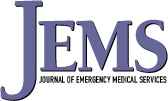

 |
 |
Caring for Our Patients & Ourselves; |

CITATION:
Perry D, Dick T. Caring for our patients & ourselves; count your fingers; more stuff on restraints.
JEMS, May 2003; Vol.28, No.5; pgs 22-23.
Notable Contents of this Brief Paper
(CHAS' "Review"):
Doug Perry & Thom Dick appropriately retracted Thom's January 2003 "Tricks of the Trade" suggestion of using a choke-hold-like (or "sleeper"-hold-like) maneuver for "stabilizing the patient's head and neck" ... i.e. "restraining" the patient's head by "cradling" it with someone's ARM.(1)
 In it's stead, they suggest "If you leverage your forearms as struts against the head end of your cot, you could cup your hands around the patient's mandible and, thus, physically limit the patient's ability to flex or rotate their neck while they're being restrained."
In it's stead, they suggest "If you leverage your forearms as struts against the head end of your cot, you could cup your hands around the patient's mandible and, thus, physically limit the patient's ability to flex or rotate their neck while they're being restrained."
 Essentially, Doug and Thom are suggesting precisely what I've advocated for a long, long, time (at least since 1998): Using a "Jaw Thrust Airway Maneuver" to restrain a combative patient's head.
Essentially, Doug and Thom are suggesting precisely what I've advocated for a long, long, time (at least since 1998): Using a "Jaw Thrust Airway Maneuver" to restrain a combative patient's head.
 Here's an excerpt from Part 3 of my All Tied Up & No Place To Go Article(2):
Here's an excerpt from Part 3 of my All Tied Up & No Place To Go Article(2):
The biggest advantages to this maneuver are:This airway-maneuver-head-restraint really works! But, what these authors fail to point out is, it is an EXHAUSTING technique to perform! Even a very strong provider's fingers will quickly begin to ache and cramp when performing this form of head restraint on an individual who is divinely inspired (INVOLUNTARILY CUED) to act out in such an excessively exertive manner. SO, you must have another provider ready to take over the head control ... even during fairly short transport times (5 to 10 minutes) ... especially if the patient is intubated.
1. no threat of airway occlusion
2. no threat of vagal stimulation (as may occur when a patient's head is forcefully turned to one
side) [or when "cradling" the patient's neck with your elbow!(1)]
3. minimal threat of bystanders and family members observing this maneuver and perceiving it
as being a "cruel" or "excessive force" activity on the part of care providers.
Ah! The authors managed to address at least one CARE-PROVISION issue in this paper:
 "... as soon as you get the patient fastened to the cot, place him on mask oxygen – especially if he persists in struggling. That counters his oxygen debt and has a side-benefit of posing a barrier to continued spitting or biting."
"... as soon as you get the patient fastened to the cot, place him on mask oxygen – especially if he persists in struggling. That counters his oxygen debt and has a side-benefit of posing a barrier to continued spitting or biting."
 Again, using a nonrebreather oxygen mask as a "spit shield" – while simultaneously administering oxygen (what a concept!) – is something I've advocated since 1996(2). Additionally, oxygen administration is a treatment LONG REQUIRED by even Basic EMT protocols when CARING FOR individuals who have an altered level of consciousness.
Again, using a nonrebreather oxygen mask as a "spit shield" – while simultaneously administering oxygen (what a concept!) – is something I've advocated since 1996(2). Additionally, oxygen administration is a treatment LONG REQUIRED by even Basic EMT protocols when CARING FOR individuals who have an altered level of consciousness.
Unfortunately, Doug and Thom degenerate from there ... continuing to advocate the restraint of the patient's arms across his chest (for entirely ridiculous reasons, and in spite of the fact that this restraint method will seriously interfere with thorough medical evaluation, vital signs measurement, and care provision) ... advocating head-covering, hood-like devices for spit shields "if the patient shucks the [oxygen] mask" ... and so on.
But, bless Twink Dalton for having the authors add at least one great bit of advice about documentation concerns related to use of restraint!
CHAS' "REVIEW" REFERENCES:
(1) Dick T. Straight shot; use of restraints, part 2. JEMS, January 2003; Vol.28, No.1; pgs 98-101.
(2) Miller CD. All tied up & no place to go – part 3. August 1996, 1998, 2001.

I've posted this JEMS paper in PDF file format.
If you don't have an Adobe Acrobat PDF file program, you can download a FREE version HERE.


 Email Charly at: c-d-miller@neb.rr.com
Email Charly at: c-d-miller@neb.rr.com